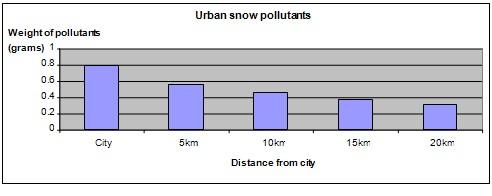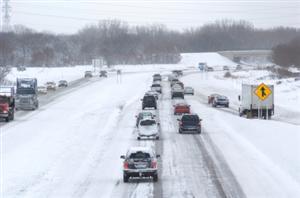| Complexity level: | 5 |
| Project cost ($): | 30 |
| Time required: | 1 hour to prepare, 2 days for experiment |
| Material availability: | Easily found |
| Safety concerns: | Basic safety requirements |
Hypothesis
The amount of particles and contaminants in the samples of snow decreases when collected further away from the city.
Overview
Pollution in snow
Snow normally looks white and clean. However, it's surprising that snow may actually contain many contaminants such as toxins, heavy metals, viruses and bacteria. Snow is contaminated when it is stepped on or when pollutants are splashed onto it.. Snow also collects dust and dirt carried by the wind. It also collects contaminants in the atmosphere as it falls to the ground.
Snow has the interesting "ability" to remove pollutants in the air by forming itself around dust particles. The formation of snow occurs in water vapor that moves in clouds of cold air. The water vapor "adheres" to pollutants or dust particles in the cloud and then other water molecules also begin to attach themselves to it, until snow crystals are formed.Snow crystals continue to grow in size and remain in the air for a few hours before they fall to the ground. During this time, snow crystals continue to collect pollutants and particles in the air. So, snow really isn't as clean as it looks.
Scientific Terms
Materials
The materials required for this science fair project:
- 5 pails
- A road map or GPS tracking equipment
- A digital weighing scale, able to measure weight in one-hundredth of a gram
- 5 pieces of filter paper
- 5 beakers measuring 300ml each
- A car and driver
Procedure
1. For this science fair project, the independent variable is the location where the snow samples are collected i.e. within the city and 5km, 10km, 15km or 20km away from the city. The dependent variable is the weight of the debris found in the snow. This is determined by using a weighing scale to measure the weight of the debris. The constants (control variables) are the chosen locations, the time of the day and the volume of snow collected.
2. The 5 pails, beakers and pieces of filter paper are labeled as “City”, “5km”, “and 10km ”,“ 15km ”or“ 20km”. Study the road map and select 5 locations for collecting the snow samples. The chosen locations should be in the city and at 5km, 10km, 15km or 20km away from the city.
3. Check the weather forecasts and select a day on which snowfall is expected. Place the pails at the 5 chosen locations. With the help of a driver, we made our way to the chosen locations and placed the pails in positions where snow could fall directly into the pails. Make sure that the pails are dry and clean to begin with. Ensure that the pails placed clear of roof edges and tree canopies.
4. After the snowfall on the following daymake a return trip to the chosen locations to collect the snow samples in the pails. Then, have the samples brought back to the lab for testing. Make sure that the snow does not melt (don't place the pails in warm spots).
5. Check the weight of the filter paper on the digital weighing scale. Fold the filter paper to form a cone. Weigh 200grams of snow from each pail and placed the snow inside the filter paper cone. The cone is then placed over a beaker. Allow the snow to melt and drip into the beaker while the debris remains on the filter paper.
6. The filter paper is allowed to dry and the weight of the filter paper is measured once more. The difference in the weight of the filter paper before and after the experiment is recorded in the table below. Do this for all 5 snow samples.

Results
The results show that the snow sample collected in the city had the most amount of debris and the snow sample collected at the location furthest from the city had the least amount of debris.
| Location | City | 5km | 10km | 15km | 20km |
| Weight of debris (gram) | 0.79 | 0.56 | 0.47 | 0.38 | 0.37 |
The results of our science project experiment are set out below.

Conclusion
The hypothesis that the amount of contaminants found in snow decreases in locations situated further away from the city, is proven to be correct.
Children love to play with snow and even eat snow. However, snow in urban areas contain a lot of pollutants. Snow that is yellow, black, brown or pink in color must be avoided completely. There's a reason why the snow appears yellow in color - it's altogether possible that it contains animal urine. If the snow is black and brown, it probably contains large amounts of dirt. Pink snowis probably pink becauseof bacterial contamination.
Also consider
Try to repeat the experiment in different locations or at different times of the year.
The experiment can also be repeated using rain water instead of snow. Would there be a difference if the snow is collected right at the start of a snowfall?
References
The clean snow experiment - http://www.examiner.com/x-28900-Mankato-Homeschooling-Examiner~y2009m12d14-The-clean-snow-experiment
Don’t eat yellow snow, or black, or brown, or pink - http://www.treehugger.com/files/2007/11/ask_treehugger_25.php

